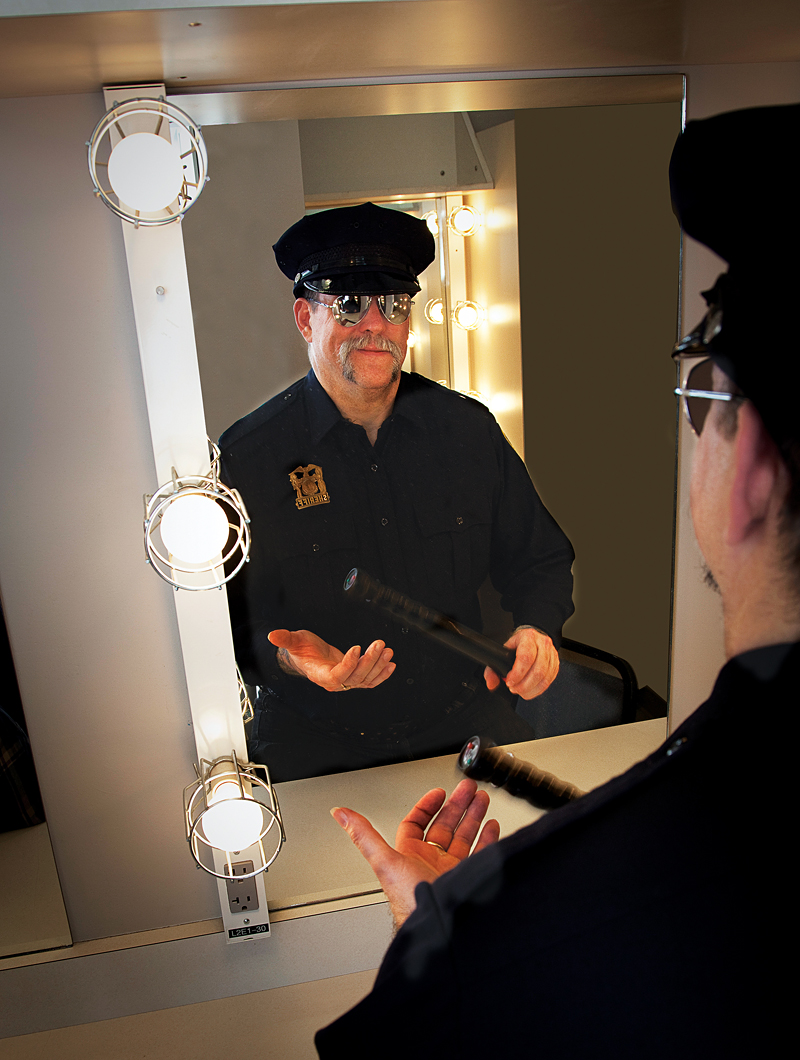Malaika Brooks was driving her 12-year-old son Jahrod to the African American Academy on Beacon Hill one morning in 2004 when a Seattle cop pulled her over. It was the beginning of a traffic infraction that has so far cost city taxpayers $345,000 in legal fees, and which left the then-pregnant Brooks with Taser scars and the determination to pursue an alleged police-brutality case for what appears to be a record seven years and counting.
Officer Juan Ornelas, who’d caught Brooks on radar, came to her window and said she’d been doing 32 in a 20-mph school zone. Brooks denied it, explaining he must have mistaken her vehicle for the black Honda that had been racing along in front of her. Brooks, then 34, handed her license to Ornelas as her son got out and walked on to school. Ornelas wrote the ticket and handed it to Brooks for her signature. She declined. Signing it, she mistakenly thought, would be an admission of guilt. Ornelas told her that if she didn’t sign the traffic ticket, he would issue a criminal citation for refusing. She could then be arrested and taken to jail.
Brooks said she wasn’t signing anything, but would accept the ticket otherwise. Ornelas then called Sgt. Steve Daman to the scene. Officer Donald Jones also showed up. When Brooks told the sergeant she wouldn’t sign, Daman told Ornelas and Jones to “book her.” Brooks was asked to step from the car. She refused. Jones then displayed a Taser stun gun and asked if she knew what it could do to her. Brooks told the officers she was pregnant. “How pregnant?” one asked. Her baby was due in two months, she said. She refused to step out.
After a discussion among the officers, Ornelas opened the driver’s door, reached in and grabbed Brooks by the left arm as Jones put the device to Brooks’ thigh in touch-stun mode and shocked her with 50,000 volts. She began honking her horn, screaming for help as she resisted. Jones quickly administered another shock to Brooks’ arm, and she stopped blowing the horn. Then he shocked her a third time, in the neck, and Brooks fell over, unable to move. She was pulled out and held face-down on the street while being handcuffed. After an examination by fire-department medics, she was jailed for resisting arrest. The charges ultimately were dismissed.
Brooks, who two months later gave birth to a healthy baby girl, has been in court ever since, contending that the police used excessive force. Her case worked its way up to a federal appeals panel last year, where two of three judges ruled that the police had acted within the law and used proper force. But after another appeal, Brooks’ attorney Eric Zubel was allowed to appear before the full 11-member court at a session in Pasadena, Calif., in December to re-argue the case. A decision is due soon.
Ted Buck, of law firm Stafford Frey Cooper, which has been contracting with the city for 40 years to defend Seattle police officers in court, says Brooks was Tasered not because she was speeding, “but because she committed two separate crimes,” resisting and refusing to sign the criminal citation.
“If the police had done their job right,” counters Zubel, “this never would have happened.”
This debate might have ended long ago with the presence of video footage. But there was none. Seattle police began to install dashboard cameras in 2002, equipping just 16 of 220 vehicles. They have been adding them since, and now 275 vehicles sport the $5,000 cameras. The city is also contemplating equipping each officer with a lapel camera. But the police cruiser in Brooks’ case was not outfitted with video, nor were any security cameras or witnesses with video-capable cell-phone cameras nearby to catch police face-planting a pregnant woman. Imagine that on TV.
“The problems we are addressing today have been around for a long time,” says Zubel, an attorney for 37 years. “Had there been videotape of her arrest, there would have been a much better chance of settling the case. Tape is probably the biggest difference in these cases today.”
See a list of incidents here.
Seattle Police Officers’ Guild President Rich O’Neill says that of the 1,250 officers in the Seattle Police Department, 85 percent have never had a complaint filed against them, and only five had three or more complaints leveled against them in 2009. Use-of-force incidents have declined three years in a row, he says, which SPD confirms, dropping Seattle’s force use to 20 percent less than the national average.
But that doesn’t seem to be the public’s perception of Seattle cops today, and that may have a lot to do with videotape. Nine out of 12 use-of-force cases occurring from 2008 through 2010—most of them still under police or court review—include video taken by car and security cameras or witnesses. Most of the current high-profile cases likely wouldn’t be known to the public had it not been for the video revolution.
One of the first 2010 videotape cases—footage that some SPD officials attempted to keep from being aired on local TV—shows a prone 21-year-old Martin Monetti being kicked in the head last April by SPD officer Shandy Cobane. He told Monetti— mistakenly detained as a robbery suspect—that if he moved, “I’m going to beat the fucking Mexican piss out of you, homey.”
Photographed by freelancer Jud Morris, the video eventually went viral, also showing officer Mary Woollum stepping on the legs of another suspect. But that was after KCPQ-TV, which works closely with local officers on its Washington’s Most Wanted series, sat on the footage at the urging of police, according to Morris. He took the video to KIRO-TV, which ran it a few days later. KCPQ then ran its clip. Steve Kraycik, the station’s news director, denied suppressing the film, then resigned.
The shooting death of 50-year-old John T. Williams, a Native American wood-carver, was only partly caught on videotape, but the audio was key, revealing the officer’s commands and the timing of his shots. Williams was slain last August when confronted by Officer Ian Birk at the corner of Boren Avenue and Howell Street. Birk, 27, a cop just two years, told the inebriated Williams to drop the knife he carried, then, in four seconds, made his decision to shoot, firing four rounds. Though an SPD Firearms Review Board found Birk acted without justification, and only one of an eight-member inquest jury found Williams posed a threat to Birk, King County Prosecutor Dan Satterberg, facing the legal hurdle of trying to prove the officer acted with malice, chose not to file charges last week. Hours later, Birk submitted his resignation.
Those and other videotaped incidents prompted the Department of Justice in January to announce a preliminary civil-rights investigation of SPD operations and procedures. The review, requested by the ACLU, the NAACP, and other community groups, began last week and includes FBI interviews with citizens, police, and City Hall officials. It is somewhat similar to the DOJ probe of the King County Jail in 2006, which led to a settlement and the ongoing monitoring of the jail to ensure prisoners’ rights.
The Guild’s O’Neill, among others, thinks the feds will not seek drastic changes, just recommend a course correction. But without pictures, would the DOJ even be here? And would the TV- and Internet-viewing public be reacting as angrily as it is in protests, online comments, and public hearings, some demanding the chief of police’s head?
Clearly some are empowered by what they’ve seen on their screens. After Satterberg’s no-charges announcement, family and supporters of Williams showed up at a press conference held by Mayor Mike McGinn, urging him to speak out. “Do you feel any shame?” asked one, any “outrage?”
“I’m not going to sit here and yell and scream about it,” replied McGinn. But others have, including demonstrators who marched noisily through downtown that night, chanting “Lock ’em up, throw ’em in jail, killer cops get no bail!”
They and others think the videos amount to Cops Gone Wild. Which raises the question: Has there been an increase in the number of use-of-force incidents, or just in the number of incidents caught on camera? And are those videos giving a clear picture of what’s happening between cops and citizens on Seattle’s streets?
SPD’s internal investigations unit, the Office of Professional Accountability (OPA), hasn’t yet released its 2010 annual report. But police attorney Buck, whose firm is representing a number of videotaped officers, including Birk, says, “I have seen no evidence that there has been any significant change in the number of suspect/police encounters in the past several years.” (SPD statistics show 124 force complaints in 2007, 112 in 2008, and 79 in 2009.)
Yet there is a perception of an epidemic of sorts, he concedes. “First is the increase in the interactions caught on video, which brings such encounters more acutely to the mind of the average citizen. It’s easier to skip over a written version of an event than it is to overlook video footage. Second, average citizens are not used to seeing real-life confrontations. We all try to avoid that sort of thing when possible, and most people simply never see actual physical fights or struggles.”
The images are thus typically shocking, he says, and with a dozen SPD videos—nine of them involving minority suspects—available on the web, it’s difficult not to perceive a streak of cop vigilantism in the Emerald City.
Jake K. Baijot-Clary, for example, was arrested for assault outside a Ballard bar last December. Clary, 21, was face down on the sidewalk, hands cuffed behind him, when SPD officer Garth Haynes put a foot on Clary’s head, bouncing his face off the sidewalk. A cruiser videotape also shows another officer quickly pulling Haynes off to the side. Police are reviewing the case, and Haynes has been reassigned.
Then there’s 47-year-old Daniel Macio Saunders. The Seattle man is suing the department after three officers used a Taser and allegedly beat him in 2009 with fists, batons, and flashlights at an SPD evidence facility after he was mistakenly released from jail. But was it a beating or a subduing? A video shows Saunders resisting arrest, suggesting he was punched and clubbed in response. Likewise, teenager Joseph (Joey) Wilson, a special-ed student, is suing SPD after suffering a broken nose and a concussion he says were caused by cops after a 2009 jaywalking incident. Police said Wilson was combative and refused to get out of the street, and video taken by a neighbor shows he struggled and resisted. The officers were later exonerated.
And was the case of 49-year-old John Kita brutality or necessary force? He claims in a federal case that he was beaten and kneed by officer Kevin Oshikawa-Clay after the officer discovered Kita fighting with a woman under I-5 in Seattle, an incident recorded on police video in February 2008. The officer, who was administratively exonerated, said Kita resisted and fought him and he had been required to use “minimal” force to take him down.
One of the most memorable recent videos shows 19-year-old Marilyn Ellen Levias after she was stopped for jaywalking in Rainier Valley last June by officer Ian Walsh. A friend, Angel L. Rosenthal, 17, then intervened, pushing the officer. Walsh responded by punching her in the face. The impression was that Walsh was the evildoer, yet Rosenthal later pled guilty to assault and apologized to the officer, who was cleared of wrongdoing.
Also among the video pantheon, Yvette Gaston, 42, then a county juvenile probation officer, was physically restrained by police in 2008 while trying to help a juvenile who’d been stopped by police. The city, which has cop-car video footage of the incident, claims officers were surrounded by an “unruly” crowd and that Gaston interfered. Charged with assault and obstruction, she was exonerated in municipal court, and has filed a federal lawsuit.
Additionally, 28-year-old Demetrius James claims in a federal lawsuit that he was Tasered and shot in 2009 after police approached him while he tried to drive out of a parking lot on South Jackson Street. An officer who felt James was trying to run him down fired his handgun five times, with one bullet striking James in the wrist. James jumped from the car and ran, but was ultimately apprehended. A video captured some of the events. James was charged with assault, and after two mistrials and 14 months in jail, pleaded down to a lesser charge.
Though some of the recent footage seems to favor the arrestees’ claims, Buck’s firm encourages cops to use video as much as possible. “Where videos are used extensively, the result has been overwhelmingly positive for line officers,” he says. “The great majority of suspect complaints about officer conduct are at least embellished, if not outright fabricated. Video can reveal such claims for the phooey they often are.”
But Jennifer Shaw, deputy director of the American Civil Liberties Union’s Seattle chapter, says the recent clips are damning, showing a pattern of “repeat incidents of people of color ending up on the ground with a police officer over them . . . caught on videotape.” Some are unquestionably brutality, she claims. “The easy ones are the ones that are caught on videotape. Those are the ones that are hard to deny. You have it before your eyes and we can’t really be asked to distrust what we’re seeing.”
O’Neill, the guild leader, thinks that’s overblown. “With the exception of the John T. Williams incident, not one of the individuals involved in the different video incidents sustained any serious injury,” he says. “Does that not show that officers are using some form of restraint when applying force?”
He thinks too many people, including top cops and politicians, misinterpret the video snippets. Greg Nickels’ administration had more experience dealing with the media, he says, while Mayor Mike McGinn’s people “come out right away with a statement before they even bother to look at the situation in the proper context.”
The press, he adds, “is also not blameless here. Why do they keep using the term ‘stomp’ or ‘stomping’ without detailing that the individual involved was not injured? If I truly stomped you, would you not expect to be injured?”
Former police chief Andrew J. Scott, now a Florida-based expert police consultant, says the increase in videotape is a good thing for law enforcement and the public at large. “There is no downside to having an in-court video,” he says. “But one thing I also caution the public is that what they see is a snapshot, not the entire encounter,” i.e., events such as the crime being committed, a foot or car chase, or other adrenalin-stoking prelims. “The public does not understand to any degree the appropriate application of the use of force. I get calls almost weekly where someone has been apparently hit or Tased, and some cases are valid, others are not.”
Though most police work is routinely peaceful, use-of-force incidents, like fights at a hockey game, get viewers’ attention. It’s what the producers of the TV show Cops go looking for, says Scott, “and I would never have my law enforcement agency photographed by Cops. It scares the hell out of me. It always looks like excessive use of force. The public’s view is skewed because they don’t know what the law allows an officer to do, and what the full circumstances were.”
When confronted during an arrest by a suspect attempting to flee or fight, police are advised to gain the upper hand quickly by meeting force with superior force—moving quickly and powerfully, shouting commands to subdue the subject. In a one-on-one event, such as the Williams shooting, officers are advised to call for backup and stay a safe distance from the subject. (Officer Birk was faulted for failing to do either: “We found very little to show he was within training and policy” rules, says Deputy Chief Clark Kimerer).
Even when done appropriately, arrests often result in complaints against police (the department is currently handling 500 complaints against its officers, dating back a year). And as the more recent footage of incidents shows, some officers, despite O’Neill’s claims, inarguably used unnecessary force. An October incident, in which a teen with his hands up was kicked three times in the body and head by plainclothes officer James Lee, has resulted in a $450,000 lawsuit against Lee and the department. Lee has since admitted that he falsely claimed in his report to have first “struggled” with the youth before kicking him in self-defense.
Underscoring the problem, observers note, is SPD’s fielding of green officers. One-third of the force has fewer than three years’ experience (besides Birk, that group includes several other cops involved in the video incidents). About 250 veteran SPD officers are facing retirement, meaning more new recruits will be on duty soon.
Police consultant Ed Mamet, a retired New York City police captain, thinks that inexperience reflects a stature issue in Seattle, as elsewhere. “What I have observed in my work is that the quality of police officers today is not that of my generation,” he tells us. “Many of these new officers lack the discipline and work ethic that those of my generation had, and these deficiencies manifest themselves in the way they treat members of the public.”
Mike McGinn and Wes Uhlman have met twice now, sitting in the mayor’s expansive offices on the seventh floor of City Hall and chatting about police turmoil, an issue they have in common. When Uhlman, now 75, was elected in 1969 as the youngest mayor (age 34) in Seattle history, SPD was in chaos as two grand juries began to investigate a police-payoff system that grew out of City Hall’s quarter-century tolerance of vice. A corrupt departmental leadership was being marched off to court, and Uhlman began to bring in a series of visiting police chiefs, six in a year, to clean house.
McGinn, who took office in 2010, a year highlighted by a half-dozen incidents of alleged police brutality and preceded by another half-dozen incidents from 2008–2009 under Nickels and then–Police Chief Gil Kerlikowske, wanted to know Uhlman’s secrets. McGinn had picked a new chief from within, 30-year SPD veteran John Diaz, in the middle of a growing uproar. By January, when the two mayors first met, the DOJ was preparing to review SPD’s practices as more incidents emerged, and it was probably going to get worse before it got better.
At McGinn’s invitation, Uhlman—an attorney, as is McGinn—gave the new mayor a candid assessment. “I didn’t use the words ‘trigger-happy,’ ” Uhlman says of his talk with McGinn, “but I said the department’s procedure on use of deadly force is in serious question.”
Uhlman described for McGinn a contextual scenario of the events, noting they had been preceded by the Halloween 2009 murder of Seattle police officer Tim Brenton, followed a month later by Maurice Clemmons’ bloody-Sunday massacre of four officers in Lakewood. “Cops face death on a daily basis. It’s part of the job to be apprehensive,” Uhlman says. “But I said the issue, which has to be dealt with in training, is restraint. In these incidents, some of the actions are just inexcusable.”
The two politicians also discussed how to finesse change at the department. “There will be difficult personnel decisions that have to be made, which will not be readily accepted by the department at first. But Mike has political cover with this investigation,” Uhlman says, alluding to the federal review. “It’s fresh and new, and the FBI will probably come out with some incisive kinds of suggestions and findings, and that might be the best time for him to make any difficult moves in the department.”
After their meetings, McGinn announced this month at a public forum on police accountability that the department was undertaking a complete review of its training practices, then cited his sessions with Uhlman. “Any time I speak to Wes,” McGinn said, “I feel a lot better.”
McGinn tells people he worries about a departmental “culture” that tolerates excessive force, and, if it does exist, he’s determined to root it out. “Cultures take time to build up and they take time to break down,” he says. Meanwhile, City Council member Tim Burgess, a former cop, has no easy answer for what fosters “a police culture of ‘us versus them,’ ” he says, and believes it’s a mistake to think “a few tweaks or new rules and training changes will resolve all the public’s concerns.”
Some of the crowd attending a recent police-accountability forum made that discontent clear, jeering and interrupting panel speakers, one exclaiming of the video incidents, “These were not fucking accidents!” Two demonstrators were asked to leave.
The guild’s O’Neill says the problem in large part lies with those who resist arrest. Instead, they should “obey the command” even if the cops are wrong. In other words, don’t get mad, get even. “What is the alternative?” he asks. “To be allowed to disobey the order, actively resist, and then when the situation is escalated, absolve the subject completely for any part in causing the situation to escalate? I hope that is never the situation we put our officers in.”
But Nicole Gaines, president of the Loren Miller Bar Association for people of color, thinks that is asking less of cops and more of citizens. Officers, she says, “are expected to act and respond in a manner that is higher than those they are necessarily protecting. To ask the public to always take the high road when dealing with the officers, when it’s the officer’s responsibility to be the professional, is absolutely unacceptable.”
It’s ironic that, in the midst of more video exposure, one of the complaints about SPD is that it lacks transparency. Gaines, for one, thinks police disciplinary reports should be as accessible as, say, attorney disciplinary reports. “As an attorney,” she says, “if I do something wrong, you can go on the bar’s website and see everything I did.” The City Council is given access to police disciplinary reports, she adds, so why shouldn’t the public be?
According to the OPA, of 198 complaint investigations completed in 2009, only 12 percent were sustained. But what, really, is known about the process and facts of those cases? Onetime deputy mayor Ann Levinson, a civilian outside auditor of the OPA—which replaced the even more secretive Internal Investigations unit in 1999—agrees that access to reports is difficult (there are monthly summaries on OPA’s website), and concedes the unit does not “do a very good job of communicating to the public.” They’re working to change that, she adds.
This blue-wall mentality concerns former Seattle U.S. Attorney Mike McKay, long a police ally. Now in private practice with his brother John, also an ex–U.S. Attorney, McKay says he’s been stonewalled by SPD in attempts to pry records from the department in a case of alleged brutality. “Despite what the [state] Open Records Act requires, SPD simply refuses to hand over some records,” he says. “They cite ‘privacy issues.’ They force you to sue them. Most people just shrug and walk away; they can’t afford a lawsuit. I see this as an institutional effort to protect officers. I would hope the DOJ will be looking into the department’s efforts at a cover-up in these cases.”
The department has also been caught failing to turn over its videos to defendants in criminal trials. Seattle artist Maikoiyo Alley-Barnes received a $185,000 settlement in 2007 from the department after filing a federal civil-rights lawsuit over his 2005 arrest. He was badly beaten, and photos of his bloodied, swollen, puffed-up face made him a poster boy for police brutality. Dash-cam audio/video of the incident in a Capitol Hill alley revealed blows being struck and a woman saying “Oh, my God!” while Alley-Barnes pleads with officers to “please stop kicking me!”
Police withheld the video until three days into Alley-Barnes’ municipal court trial, leading to dismissal of the case. Then–Chief Kerlikowske, now President Obama’s drug czar, refused to discipline any of the officers even though punishment had been recommended by an internal investigator.
Seattle cyber-security expert Eric Rachner also sued police last year for withholding video of his arrest during a drunken game of street golf. Rachner refused to show an officer identification and was arrested for obstruction; police said they no longer had a video of the incident when Rachner asked about it. But after charges were dropped, he learned the video was still in SPD possession, and he and the department settled a lawsuit out of court in October.
Video, like electronic and paper reports, falls under the public-records act, and McKay thinks “Seattle is one of the worst” U.S. cities for wrongly withholding such evidence. He recently got into it with the mayor’s office, claiming Chief Diaz was engaged in a “full-blown cover-up” within the department. In the wake of media reports, mayoral attorney Carl Marquardt responded in an e-mail that McKay’s charges were flimsy: “John Diaz is an honorable guy. You called him a liar on the front page of the paper, and you’ve got nothing?”
McKay represents 19-year-old Evan Sargent, who claims he was threatened by an armed off-duty police officer, Don Waters, 46, in a 2009 road-rage incident. The two met in an alley near the West Seattle Junction that Waters was using as a shortcut, but was obstructed by Sargent’s parked pickup. An upset Waters allegedly smashed Sargent’s side mirror with his fist, and a frightened Sargent grabbed a baseball bat to fend him off. Waters got a handgun from his car and pointed it at Sargent, finally identifying himself as a police officer. Sargent was then arrested for investigation of assault on a police officer.
In a letter to one of his successors, U.S. Attorney Jenny Durkan, McKay cited the case as another reason why the DOJ should be investigating Seattle police. Durkan, whose office says she took the letter under advisement, worked with McKay to help set guidelines for the OPA in 1999. McKay says SPD improperly tried to protect Waters by attempting to falsely charge Sargent with a felony—lending credibility to Waters’ claims—but prosecutors declined. Seattle city attorney Pete Holmes wouldn’t file misdemeanor charges either.
McKay says Waters lied about the run-in, and that police dismissed evidence showing Waters was the aggressor. That Diaz may have approved of this was “outrageous,” McKay wrote to Durkan. “If the unlawful actions of ranking SPD officers following Sargent’s unlawful arrest serve as an example,” he continued, “SPD may have acted to conceal other civil-rights violations to shield officers from consequences for their wrongdoing.”
Mayoral attorney Marquardt explains, “It looks like [the cop and civilian] both behaved badly. He [Sargent] admitted he took checked swings, and the city attorney couldn’t file against either one. The police auditors took a look at it, civilians reviewed it, and the complaint was not sustained. It’s not like someone had a finger on the scale.” Marquardt wouldn’t comment on a rumor that McGinn’s office mulled over filing a bar complaint against McKay for his “cover-up” comments, but a mayoral source who requested anonymity said “McKay would have more credibility if he wasn’t trying to roll us for a couple hundred thousand for his client.” Says McKay: “I don’t think they’re happy that we’re pressing this case, not walking away like so many people do because they can’t get the records.”
Of course, McKay wishes he had some videotape to work with. He agrees with Zubel, Malaika Brooks’ attorney, who says it can make or break a case. “Police accountability,” says Zubel, “has certainly improved with the advent of tape. And the public is able to see more of how their police department is functioning.”
Scott, the consultant who represents both police and defendants in court, says that while video can be helpful, SPD has “an obligation to educate the public about their procedures, to explain that they did everything right, or wrong. They’re competing with these videos. An agency has to be extremely transparent with the community. There can’t be doubts. I don’t think that’s the case today, or we likely wouldn’t be having this discussion.”
And, as the video hits seem to keep on coming, it’s far from over.









